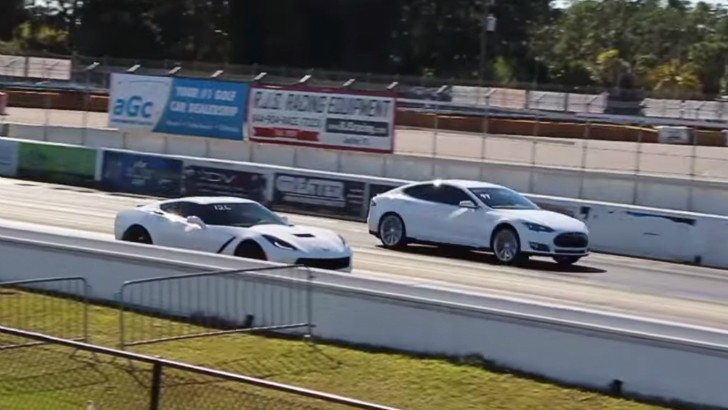When Elon Musk tweeted about the then mysterious “D”, many of us were wondering if that’s an innuendo about a particular bit of the human body. As things turned out, the fourth letter of the alphabet was actually a teaser for the Tesla Model S P85D, an electric sedan that can seat five adults in complete comfort, yet accelerate from 0 to 60 mph (96 km/h) in a brisk 3.2 seconds.
At first, that figure was unbelievable. How can an all-wheel drive, dual-motor Model S outperform the best from Merc, Bentley and even the gobsmacking Dodge Charger SRT Hellcat? As it’s always the case with such barrier-breaking innovations, the P85D was immediately put to the test (also known as drag racing).
Fresh owners of the 2015 Tesla Model S P85D started to go head to head with big names such as the Challenger SRT Hellcat, 911 Turbo S, Aventador, you know, feats that were caught on camera to demonstrate how amazing the $105,670 machine is. If you’re good for the $7.5k incentive, the D’s price drops to 98,170 green dollar bills, which is what some might call great value for money.
But we’re still trying to understand what happened here: a 691 HP and 687 lb-ft Tesla Model S P85D was utterly dominated on the drag strip by a 460 HP and 465 lb-ft, LT1 V8-powered 2015 Chevrolet Corvette Stingray equipped with the Z51 performance package. It doesn’t seem real.
From our POV, the ‘Vette put the power down to the asphalt better than the P85D and maintained its lead thanks to impressive cog-swapping skills. At the end of the run, the speed trap showed 11.67 seconds at 121.21 mph (195 km/h) for the C7 Stingray Z51 and 11.79 clicks at 114.11 mph (183.64 km/h) for the P85D.
Fresh owners of the 2015 Tesla Model S P85D started to go head to head with big names such as the Challenger SRT Hellcat, 911 Turbo S, Aventador, you know, feats that were caught on camera to demonstrate how amazing the $105,670 machine is. If you’re good for the $7.5k incentive, the D’s price drops to 98,170 green dollar bills, which is what some might call great value for money.
However, drag racing isn’t as simple as mashing your foot hard on the loud pedal (warp drive pedal in the Model S P85D’s case) and keeping the back end from slithering left and right all over the drag strip.
Furthermore, many drivers don’t know that short-shifting has its advantages, a thing that doesn’t apply to the Tesla sedan’s electric powertrain. If analyzed in great detail, you’ll be amazed how technical it is to simply go fast in a straight line a quarter of a mile (400 meters).But we’re still trying to understand what happened here: a 691 HP and 687 lb-ft Tesla Model S P85D was utterly dominated on the drag strip by a 460 HP and 465 lb-ft, LT1 V8-powered 2015 Chevrolet Corvette Stingray equipped with the Z51 performance package. It doesn’t seem real.
From our POV, the ‘Vette put the power down to the asphalt better than the P85D and maintained its lead thanks to impressive cog-swapping skills. At the end of the run, the speed trap showed 11.67 seconds at 121.21 mph (195 km/h) for the C7 Stingray Z51 and 11.79 clicks at 114.11 mph (183.64 km/h) for the P85D.


